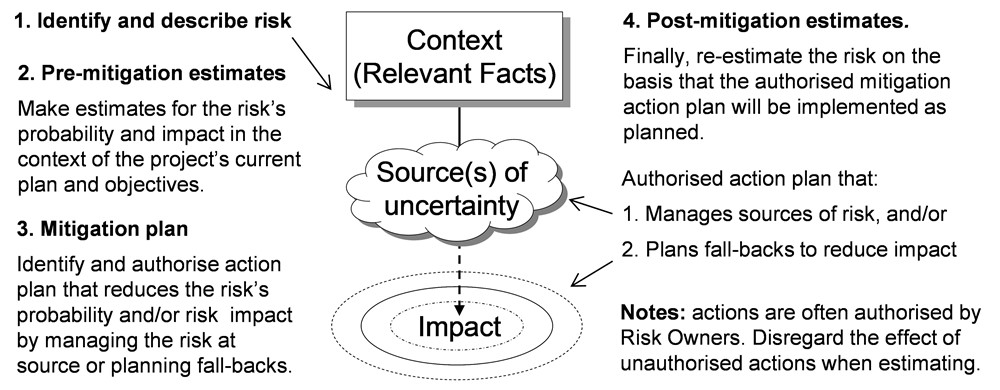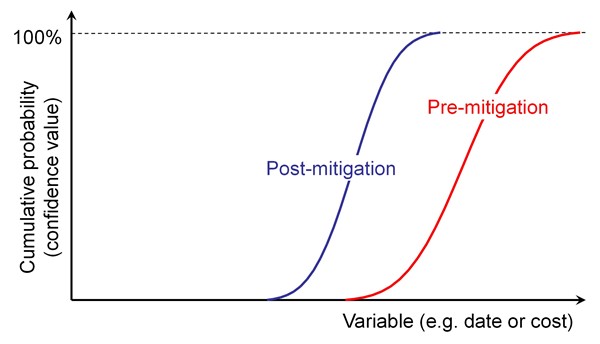A brief guide
Practical Project Risk Management
SERIES ARTICLE
By Martin Hopkinson
United Kingdom
Purposes
- Estimate the effect of risk mitigation plans on individual risks, and potentially,
- Quantify the overall value added to a project as a consequence of its risk mitigation plans.

Typical Approach to Making Pre and Post Mitigation Estimates
Definitions
Although the use of pre- and post-mitigation estimates has become common, there is scant definition of what the terms mean. Serious mistakes can be made if different people and organisations understand them differently. The following definitions are recommended.
Pre-mitigation: estimate for the current level of risk in the context of the project plan, assuming that the risk is accepted with no additional mitigation plan.
Post-mitigation: estimate for the current level of risk assuming that the project plan will be augmented by implementing the authorised risk mitigation plan.
Benefits of the Approach
- Assessing the value added by risk mitigation actions to individual risks – the cost, time and resource utilisation implications of actions can be weighed against the benefits of reduced risk exposure, thus helping to develop risk-efficient plans.
- Quantifying the collective value added to a project as a consequence of its risk mitigation plans e.g. as illustrated below

Quantitative risk models can be run with both pre and post mitigation estimates, illustrating the value added by mitigation plans.
Point to note: if post-mitigation estimates are used for such models, the cost and time implications of authorised mitigation actions should also be included in the model.
More…
To read entire article, click here
Editor’s note: This series of articles is by Martin Hopkinson, author of the books “The Project Risk Maturity Model” and “Net Present Value and Risk Modelling for Projects” and contributing author for Association for Project Management (APM) guides such as Directing Change and Sponsoring Change. These articles are based on a set of short risk management guides previously available on his company website, now retired. For an Introduction and context for this series, click here. Learn more about Martin Hopkinson in his author profile below.
How to cite this paper: Hopkinson, M. (2022). Pre and Post Mitigation Risk Estimates: A brief guide, Practical Project Risk Management, series article, PM World Journal, Vol. XI, Issue IX, September. Available online at https://pmworldlibrary.net/wp-content/uploads/2022/09/pmwj121-Sep2022-Hopkinson-pre-and-post-mitigation-risk-estimates-series-article.pdf
About the Author

Martin Hopkinson
United Kingdom
![]()
Martin Hopkinson, recently retired as the Director of Risk Management Capability Limited in the UK, and has 30 years’ experience as a project manager and project risk management consultant. His experience has been gained across a wide variety of industries and engineering disciplines and includes multibillion-pound projects and programmes. He was the lead author on Tools and Techniques for the Association for Project Management’s (APM) guide to risk management (The PRAM Guide) and led the group that produced the APM guide Prioritising Project Risks.
Martin’s first book, The Project Risk Maturity Model, concerns the risk management process. His contributions to Association for Project Management (APM) guides such as Directing Change and Sponsoring Change reflect his belief in the importance of project governance and business case development.
In his second book Net Present Value and Risk Modelling for Projects he brought these subjects together by showing how NPV and risk modelling techniques can be used to optimise projects and support project approval decisions. To learn more about the book, click here
To view other works by Martin Hopkinson, visit his author showcase in the PM World Library at https://pmworldlibrary.net/authors/martin-hopkinson/









